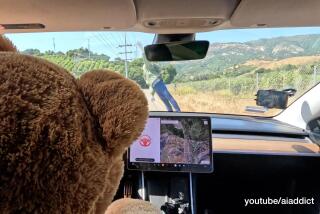When your car helps you drive
Imagine two cars talking to each other to prevent collisions.
“Connected vehicles that talk to each other and to the roadside to avoid crashes are the equivalent of seat belts and electronic stability control,” said Scott Belcher, president of the Intelligent Transportation Society of America, a nonprofit that fosters new technology to solve transportation problems in the U.S.
The Department of Transportation estimates that the Connected Vehicle Program could reduce non-impaired traffic crashes by up to 81%, Belcher said.
Although that system is still in the future, others are being used now and can help make road travel safer. Here’s a sampling of some of the technological innovations that caught my eye.
Ford
The new Ford Taurus and Explorer use radar to help with blind spots. One united is used in front and one in each of the back quarter panels help detect other cars.
Adaptive cruise control senses whether the car in front of you is going slower than your vehicle and slows down your car.
Experts say in the next five to 10 years, cars will use advanced Wi-Fi with GPS to communicate where they are, how fast they are going and where they are going. “The vehicle senses surrounding traffic, detects when a vehicle has run a red light and slows,” said Wes Sherwood, Ford’s safety communications manager. “Drivers get a heads-up display with red lights and [a] beep, beep, beep to alert them.”
GM
StabiliTrak helps the driver “steer” the car when the technology senses skidding or loss of control. It selectively applies the brakes or automatically reduces engine power to help the driver maintain control.
A new camera-based forward collision avoidance system warns the driver if he is closing in on an object or vehicle.
Using data from built-in sensors, OnStar’s Automatic Crash Response and Injury Severity Prediction alerts first responders if a crash is likely to have caused a serious harm. That way, emergency services know how the collision affected the vehicle and can prepare for the resultant injuries.
Volvo
A pedestrian detection system lets the Volvo apply full brakes if a driver doesn’t respond quickly enough to an audible warning and flashing light. Radar, mounted in the grille, locates objects and sends a signal to the camera and will identify the object (from about 10,000 human images). If it’s a human (not an object or an animal) and taller than 32 inches, the vehicle computer assigns it a number (it can juggle as many as 64 people simultaneously) and tracks that person. If the system determines the person is moving into the vehicle’s path and a collision may occur, the car will alert the driver by beeping and illuminating a red light bar on the windshield. It also “pre-charges” the brakes, which means it moves the brake pads closer to the rotor to save a few milliseconds of brake action. If driver fails to act and impact speed is less than 20 mph, the car will stop automatically. At higher speeds the vehicle speed will be cut in half.
The City Safety system (on XC60 and S60), activated at 2-18 mph, uses an infrared laser sensor to detect whether another car is moving more slowly or standing still and will apply the brakes in your car to prevent an accident or minimize the damage.
BMW
If a driver is drifting, BMW’s lane departure warning system makes the steering wheel vibrate to signal the driver. The night vision system uses an infrared camera to detect a car, person or animal and alerts the driver.
Mercedes Benz
If you car senses you’re going to hit something within 1.6 seconds, it applies 40% of available braking force if the driver doesn’t respond to three audible warnings. At .6 seconds before impact, it applies 100% braking.
The Active Blindspot Assist not only alerts the driver to another vehicle but also can initiate corrective braking to help avoid a collision.
A camera in the windshield determines if you’re veering across a solid line. It vibrates the steering wheel, and the car will brake the opposite rear wheel to straighten you up in your lane.
Attention Assist, a standard feature on most new Mercedes models, alerts the driver to take a break using input from two systems: a sensitive steering wheel angle sensor and intelligent software that monitors 70 factors, including how long you’ve been traveling, driving conditions and car interior activity (such as adjusting the radio or using a turn signal). If it detects less interior activity and you begin making abrupt steering corrections, the car sounds a tone and flashes the image of an espresso cup.
More to Read
Sign up for The Wild
We’ll help you find the best places to hike, bike and run, as well as the perfect silent spots for meditation and yoga.
You may occasionally receive promotional content from the Los Angeles Times.






